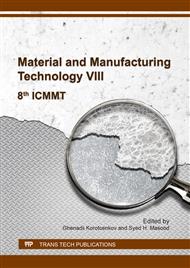[1]
Dinesh, P., Renukappa, N.M., SIddaramaiah, et. al. (2012). Electrical properties and EMI shielding characteristics of multiwalled carbon nanotubes filled carbon black-high density polyethylene nanocomposites. Composite Interfaces, 19: 121-133.
DOI: 10.1080/15685543.2012.699384
Google Scholar
[2]
Chung, D.D.L. (2012). Carbon materials for structural self-sensing, electromagnetic shielding and thermal interfacing. Carbon, 50: 3342-3353.
DOI: 10.1016/j.carbon.2012.01.031
Google Scholar
[3]
Singh, A. P., Gupta, B.P., et al. (2013). Multiwalled carbon nanotube/cement composites with exceptional electromagnetic interference shielding properties. Carbon 56: 86-96.
DOI: 10.1016/j.carbon.2012.12.081
Google Scholar
[4]
Kamal, K.K., Rahaman, A., Agnihotri, P. & Sathiyamoorthy, D. (2009).
Google Scholar
[5]
Das, N.C. & Maiti, S. (2008). Electromagnetic interference shielding of carbon nanotube/ ethylene vinyl acetate composites. Journal of Material Science, 43: 1920-(1925).
DOI: 10.1007/s10853-008-2458-8
Google Scholar
[6]
Pande, S., Singh B.P., Mathur R.B., et. al. (2009). Improved Electromagnetic Interferences Sheilding Properties of MWCNT-PMMA Composites Using Layered Structures. Nanoscale Research Letters, 4: 327-334.
DOI: 10.1007/s11671-008-9246-x
Google Scholar
[7]
Nam, I.W., Kim, H.K. & Lee, H.K. (2012). Influence of silica fume additions on electromagnetic interference shielding effectiveness of multi-walled carbon nanotube/cement composites. Construction and Building Materials 30: 480-487.
DOI: 10.1016/j.conbuildmat.2011.11.025
Google Scholar
[8]
Saini, P. & Choudhary, V. (2013). Enhanced electromagnetic interference shielding effectiveness of polyaniline functionalized carbonnanotubes filled polystrene composites. Journal of Nanoparticles Research. 15: 1415.
DOI: 10.1007/s11051-012-1415-2
Google Scholar
[9]
Gupta, T.K., Singh, B.P., et. al. (2013). Designing of multiwalled carbon nanotubes reinforced polyurethane composites as electromagnetic interference shielding materials. Journal of Polymer Research 20: 169.
DOI: 10.1007/s10965-013-0169-6
Google Scholar
[10]
Huang, X., Dai, B., Ren, Y., et. al. (2015). Preparation and Study of Electromagnetic Interference Shielding Materials Comprised of Ni-Co Coated on Web-Like Biocarbon Nanofibers via Electroless Deposition. Journal of Nanomaterials, 320306.
DOI: 10.1155/2015/320306
Google Scholar
[11]
Thomassin, J.M., Jerome, C., Pardoen, T., et al. (2013). Polymer/carbon based composites as electromagnetic interference (EMI) shielding materials. Materials Science & Engineering R 74: 211-232.
DOI: 10.1016/j.mser.2013.06.001
Google Scholar


